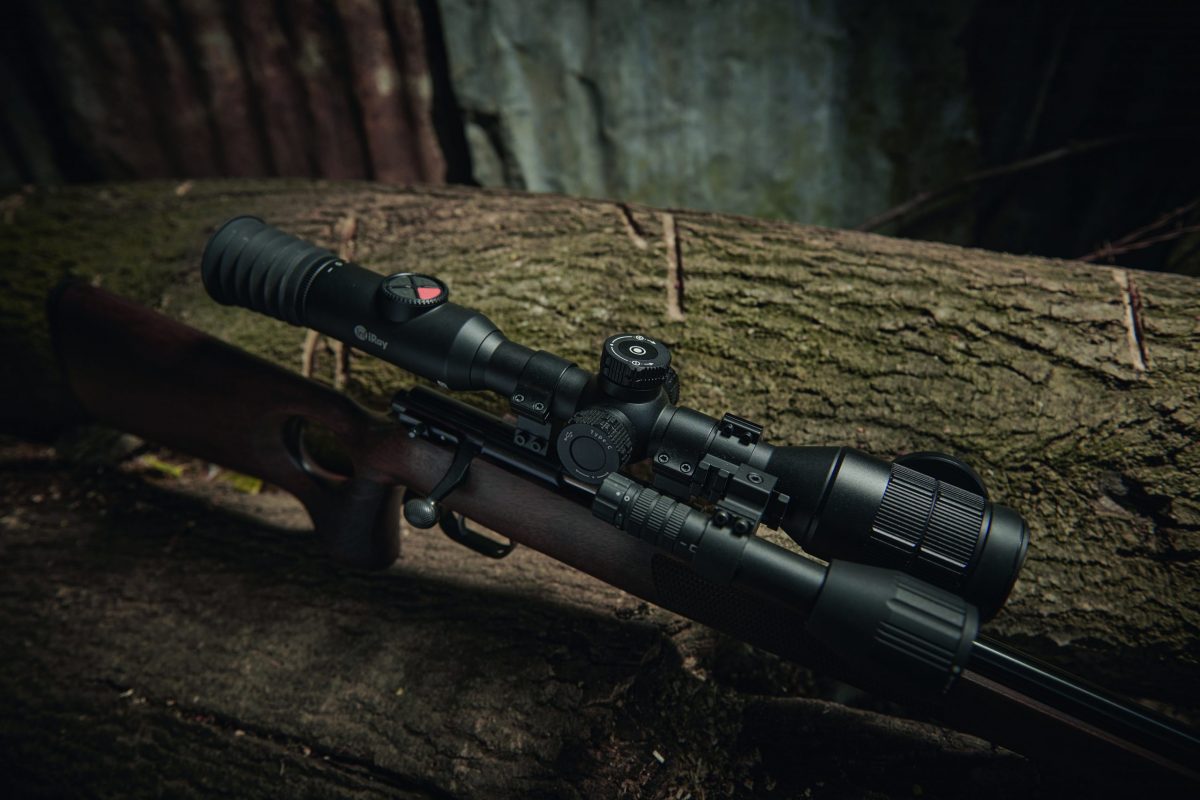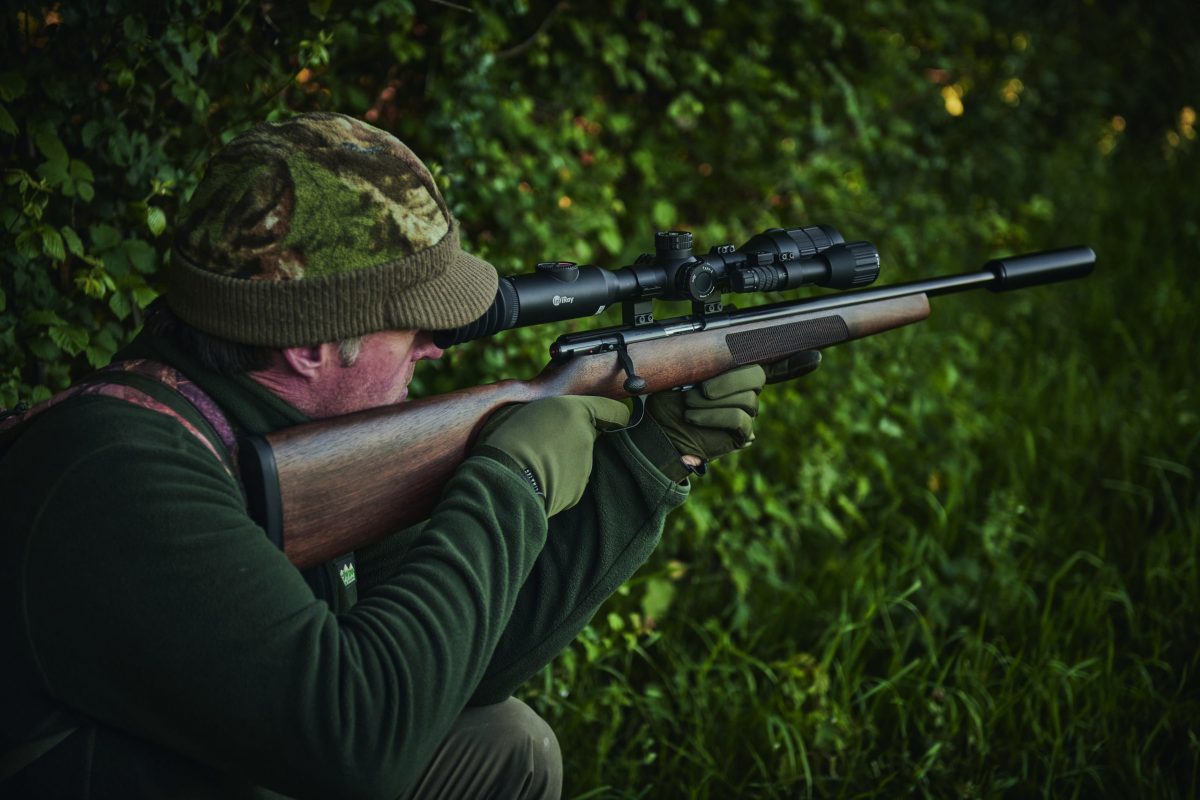Mat Manning puts thermal and infrared optics from InfiRay to the test as he pits his wits against some skittish rabbits
Infiray’s thermal and infrared optics field tested by Mat Manning
Striking the balance between simple enjoyment and technical advantage is seldom straightforward. Modern shooters are faced with a huge choice of hi-tech gadgets and gizmos that can help to put more quarry in the bag, but there is no denying that being overburdened with complicated equipment can take the joy out
of a day or night in the field.
The new breed of after-dark optics from InfiRay do an admirable job of walking the delicate line between improved performance in the field and over-reliance on sophisticated digital technology. In short, they work well without being difficult to use.
My current preference for after-dark rabbit shooting is to use a thermal spotter — because nothing tends to go unnoticed when you scan the field for heat signatures — and to pair my rifle with an infrared night-vision scope, which tends to show a little more detail of what is around and, most importantly, what is
behind your target.
Infiray Tube TD50L – key specs
PRICE: £899.95
SUPPLIED BY: scottcountry.co.uk
LENGTH: 405mm
WEIGHT: 1,100g
ZOOM: 4-16x
RESOLUTION: 1440×1080
DISPLAY: 1280×960 LCOS
FRAME RATE: 50Hz
DETECTION RANGE: 600m
OTHER FEATURES Video and photo capture to 16GB memory, rechargeable battery with 12-hour runtime, multiple reticule choice, colour viewing by day
Infiray Finder FH35R – key specs
PRICE: £2,599.99
SUPPLIED BY: highlandoutdoors.co.uk
LENGTH: 155mm
WEIGHT: 400g
ZOOM: 3.4-13.6x
RESOLUTION: 640×512
DISPLAY: 1024×768 OLED
FRAME RATE: 50Hz
DETECTION RANGE: 1,818m
OTHER FEATURES: Laser rangefinder, video and photo capture to 32GB memory, e-compass, inclinometer, rechargeable battery with six-hour runtime, choice of colour palettes, Wi-Fi connectivity
Competitive
I was therefore very happy to have the opportunity to put the InfiRay Finder FH35R thermal monocular and the Tube TD50L infrared day and night scope through their paces during a recent evening out after rabbits.
I have been using the TD50L for several months and it has performed very well over that time. I particularly like the fact that it is proportioned very much like a conventional telescopic sight, though a little longer and heavier, which gives it a very familiar feel. Its ease of operation is another big plus, along with its optical performance and very competitive retail price of £899.95.
This outing was to be my first experience of the Finder FH35R, apart from a quick set-up session in my office. Given the amount of tech and features packed into this unit, it is impressively compact at about 155mm long and around 400g in weight. Retailing at £2,599.99, this is not a cheap piece of kit and represents a very serious outlay for most shooters, so it had a lot to live up to.
It was still light when I arrived on the farm. That wasn’t a problem as the TD50L has a full-colour daylight viewing mode, selected by pressing the left button on the eye-bell. Zoom range on this scope is 4-16x. Magnification is adjusted by turning the top turret and I have found 8x to be a good all-round setting.
The FH35R comes supplied with a carry-case and neck strap, but I don’t like to have a monocular bumping around my chest when I’m trying to creep within range of skittish rabbits, so I popped the little spotter into my pocket instead.

It doesn’t come cheap, but the InfiRay Finder FH35R is a hugely effective thermal spotter
Even without the fancy optics, I was able to spot a small group of rabbits out feeding at the far side of the first field. Peering through the Finder, I could see even more — it really is amazing what is revealed by the image of the thermal monocular. A quick press on the FH35R’s laser rangefinder marked them at more than 200 yards away, so I needed to get a lot closer with my .22 subsonic ammunition.
With the Finder stuffed back in my pocket, I crept along the hedgerow, keeping myself hidden in the dark shadows as I slowly progressed towards the rabbits. After passing what I believed to be the halfway point, I took out the Finder and pinged the range at 90 yards, which was still too far for me.
Thinking ahead, I checked the range to fence posts further down the hedge until I marked one at 49 yards from where I was standing. If I could sneak close to that post, I would be about 40 yards from the closest rabbit and comfortably within range.
Clear view
There were a few anxious moments as I scuffed past brambles, but I eventually made it to my mark without sending my quarry to ground. Because I had already confirmed the range, there was no need to mess around checking it again, so I got myself into a kneeling position and set myself up for the shot.
A press of the TD50L’s standby button immediately woke it from its sleep mode, presenting me with a clear colour view of the unsuspecting bunnies. I lined up on the nearest one and rolled it over with a very solid strike. The rest of them bolted for cover at the sound of the shot, but
at least I was off the mark.
I managed to account for one more rabbit before nightfall, by which time I had reached a field where they are causing serious problems by undermining some old barns. Flicking on the infrared illuminator that comes supplied with the TD50L, I switched the scope into night mode and scanned across the fields to check everything was working as it should.
It turned out that the infrared set-up was working very well indeed — well enough for me to spot the eyeshine of a solitary rabbit in the distance. Swapping over to the Finder, I clocked it at 87 yards and proceeded to close down the range. The constant whisper of a gentle breeze rustling through the tops of the taller hedgerow trees was enough to mask the noise of my occasionally clumsy footfall and the stalk resulted in another rabbit for the pot.

Intuitive controls make for easy operation of the InfiRay Tube TD50L riflescope, by day and by night
After squeezing down the rabbit’s belly to empty its bladder and slipping it into my backpack, I decided to have another quick scan through the Finder. It’s just as well I did, because there was another rabbit out less than 30 yards away. I have no idea whether it had been out when I took the shot, or how I had failed to notice it if it was, but it ended up in the bag regardless.
There were fewer rabbits about than I had expected, but I still managed to account for seven by the time I decided to head for home about two hours after nightfall. That is not a particularly large haul, but I am sure that it would have been significantly smaller without the thermal and infrared optics. The rabbits on this patch see a fair amount of shooting pressure and don’t tend to hang around in lamplight.
Impressive
Both of the InfiRay units performed very well and functioned without any problems. The Tube TD50L is already a proven performer with standout features, including 600m detection range, 16GB internal memory for one-touch video recording, an excellent choice of reticules and a rechargeable on-board battery with sufficient runtime for extended night-time sessions.

The InfiRay Tube TD50L displays a full-colour image by day, making it a true round-the-clock optic
The Finder FH35R is similarly impressive. It boasts Wi-Fi connectivity, 1,818m detection range for a man-sized object, a rechargeable battery with six-hour runtime — and a spare — and photo capture and video recording to a 32GB on-board memory. Zoom range is 3.4x to 13.6x (stated as 1x, 2x, 3x and 4x on the menu) and image quality is very good, thanks to a decent sensor and smooth 50Hz refresh rate. It is very easy to toggle through the different colour palettes and I found ‘white hot’ to be best for picking out rabbits.
Other handy features on the display include an e-compass and dials showing horizontal and vertical incline. Apart from its main use as a spotter, I particularly liked having a laser rangefinder to hand.
Gauging distance in the dark can be hit and miss at the best of times, but this gadget takes away the guesswork and provides a clear and accurate reading of the distance between you and your target at the press of a button. It doesn’t come cheap, but shooters who do a lot of after-dark pest control are likely to find it’s worth its keep.




